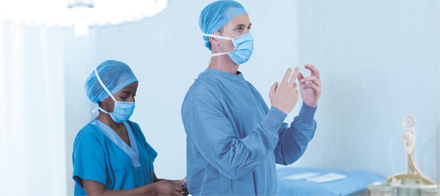New angle on pelvic floor disorders

Dr FJ Rademan of the Pelvic Unit at Mediclinic Durbanville draws on the latest surgical technology – and the collective expertise of a group of specialists – to deliver the best possible care to patients with pelvic floor problems.
As you drive north, up the N1 highway from Cape Town, you’ll pass Mediclinic Panorama – a hospital which offers excellent cardiovascular care. On the other side of the Tygerberg Hills you’ll find Mediclinic Durbanville: a newer hospital, but one which is already emerging as South Africa’s top pelvic hospital. One of the doctors behind this is Dr FJ ‘Frikkie’ Rademan, a specialist surgeon with an innovative approach to pelvic floor repair.
Nearly 25% of women experience pelvic floor problems, and those problems can be embarrassing and painful, with complications like prolapse resulting in symptoms like urinary or faecal leakage, constipation and difficulty with intercourse. When he operates, Dr Rademan uses laparoscopic surgery – a keyhole procedure which has him inserting a laparoscope (similar to a telescope) through a small incision to give him an on-screen view of the pelvic floor. Then, via three incisions in the patient’s abdomen, he uses instruments to lift and reattach the prolapsed organs using a mesh.
A fresh approach
The key difference here is the angle of approach. ‘In the past the gynaecologist and urologist would repair the pelvic floor from the bottom, doing transvaginal repair,’ Dr Rademan explains. ‘In laparoscopic surgery I come in from the top, fixing the mesh, pulling the bowel and vagina upward, and anchoring it to the sacrum. So instead of a push up from the bottom; I pull up from the top.’
This top-down approach has a wide range of benefits for the patient. ‘It’s a good procedure with good results,’ says Dr Rademan. ‘It’s durable, and recurrences are very rare. It’s minimally invasive, which means a shorter hospital stay and quicker recovery. The risks of mesh-related problems are lower and complications are rare.’
It also gives the surgeon a better view of the procedure. ‘It makes more sense for me as the surgeon to pull up into the space, against the downward force, rather than trying to plug from the bottom,’ Dr Rademan explains. The surgery is now even more precise, with Mediclinic Durbanville introducing a trial run of Robotic pelvic floor surgeries using the ground-breaking Da Vinci surgical robot. ‘They’re using the robot for prostate treatments at the moment, and it’s perfect for confined space surgery. We’re going to do the pelvic floor work with it now too.’ Dr Rademan adds that the robot’s articulated arms and swivel-head instrumentation make stitches and mesh placement easier, safer and more accurate.
The power of the collective
The top-down view of the laparoscopic surgery also allows the surgeon to see and treat more organs. ‘In the past, when working from below, you’d have a patient going to the urologist who would fix the bladder, then to the gynaecologist who would fix the vaginal area, and then they would come to the surgeon. In the end they’d see three different specialists and have had three different operations, instead of fixing everything at once from the top,’ says Dr Rademan.
This is significant, because traditionally the pelvic surgeon would focus on the posterior (rectal) compartment, while the urologist focused on the anterior compartment and the gynaecologist fell somewhere in the middle. ‘When I do this procedure I’m able to fix most of those compartments – front, middle and back – at once, without the patient having to go from the surgeon to the urologist to the gynaecologist.’
Those three specialists – surgeon, gynae and urologist – would often work in silos. The Durbanville Pelvic Unit, situated at Mediclinic Durbanville, brings the three fields of expertise together. When you visit the Pelvic Unit’s website, you’ll find three names: Dr Rademan (specialist surgeon), Dr Gawie Bruwer (urologist) and Dr Wynand Truter (gynaecologist). ‘We were the first unit in the country to have all three working together, planning together and treating the patient together,’ says Dr Rademan.
A team of experts
But the collective expertise doesn’t end there. What makes the Durbanville Pelvic Unit’s approach so revolutionary is the monthly meetings, where the Unit gathers a group of about 20 specialists in the boardroom at Mediclinic Durbanville, where they consult on the most recent cases. ‘It’s a multidisciplinary treatment (MDT),’ says Dr Rademan. ‘So it’s the three of us, plus a group of specialist pelvic physiotherapists, radiologists, a dietician, psychologist, gastroenterologist… and other consulting surgeons and doctors. We consult on average eight to 10 patients per session, and make a collective decision.’
This approach provides a clear, broad picture of the patient’s case – and it also cuts the patient’s costs significantly. ‘If you send a patient from the surgeon to the gynae to the urologist, then off for X-rays, then to the physio or the psychologist it all adds up! If I see a patient who presents with a gynaecological issue, I’ll take that to the meeting, and they’ll basically get a consultation without the associated costs.’
Conservative treatment plan
Dr Rademan takes this approach with all of his pelvic floor patients, and in many cases the final decision is not to operate. ‘I’ve been doing this procedure for five years now, and of the 200 patients who’ve come in and been given a high-resolution 3D ultrasound (which is standard for every patient), we’ve only performed the surgery on 70 of them.’
So even though he has access to an innovative surgical procedure – including, now, use of a state-of-the-art surgical robot – Dr Rademan only operates on one of every three of his patients. ‘The rest,’ he says, ‘get good, considered opinions which lead them to other treatments.’ Conservative treatment with physiotherapy and medical treatment helps nearly two-thirds of all patients, and no surgery is needed.
